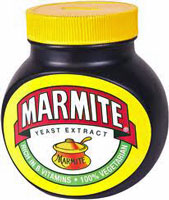 Ingredients
Ingredients- Yeast extract
- Salt
- Vegetable extract
- Niacin
- Thiamin
- Spice extract (contains celery)
- Riboflavin
- Folic acid
- Vitamin B12
Published April 2011
As the adverts say, you either love it or hate it. Many love its strong umami (savoury) flavour, and it is a rich source of the B vitamins.
Ingredients
Yeast extract is made from brewery yeast which is heated so its enzymes can produce amino acids such as glutamic acid. The mixture is treated with hot water to separate these from the dead cell walls, etc. The water is then removed to yield a paste which is rich in molecules that provide the umami (savoury) flavour of Marmite. Glutamic acid (aka E620, chemical formula C5H9NO4) acts as a neurotransmitter, and is abundant in fish, milk, and eggs. It is made industrially from acrylonitrile, which is produced on a large scale for the manufacture of rubbers and plastics, and it is used by some farmers to boost crop yields.
Salt is sodium chloride which is seen as contributing to high blood pressure and heart disease but which is nevertheless an essential nutrient and vital to the nervous system. The amount in Marmite contributes very little to our daily intake.
Vegetable extract can be made from all kinds of food plants including their non-edible parts but soya and peanuts are mostly used because these are rich in protein. This is extracted using hydrochloric acid followed by neutralising, filtering, decolourising, and concentrating. The resulting paste has a bouillon-like odour.
Niacin (aka nicotinic acid, vitamin B3, chemical formula C6H5NO2) is a water-soluble organic compound that, among other things, helps keep the level of cholesterol low. The lack of this vitamin causes pellagra, with symptoms of large running sores, lack of energy, and depression.
Thiamin (aka thiamine hydrochloride, vitamin B1, chemical formula C12H18ClN4OS) is an essential food component and lack of it causes beriberi whose symptoms are weakness, pain, and a swelling of the body. Ham is rich in thiamin and most meats contain a lot.
Spice extract contains celery. The composition of this is not specified. However, when it was realised that some people are allergic to celery then it became a legal requirement in the EU to indicate celery was an ingredient.
Riboflavin (aka E101, vitamin B2, chemical formula C17H20N4O6) is also an essential component of the diet and abundant in nuts and meat. It is produced industrially by fermentation using yeast or bacteria.
Folic acid (aka folate, vitamin B9, chemical formula C19H19N7O6) is essential for many metabolic processes including the making and repair of DNA. A woman who conceives and lacks this vitamin has a high risk of her baby being born with spina bifida (exposed spine). Folic acid is now added to breakfast cereals and bread.
Vitamin B12 (aka cobalamin, chemical formula C63H90CoN14O14P) has a cobalt atom at its heart with a cyanide group (CN) attached. It is important in the making of red blood cells and the functioning of the brain and nervous system. We need only 2 micrograms a day, and half of this comes from bacteria in our intestines.